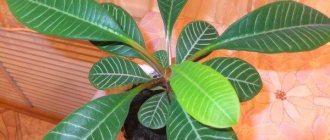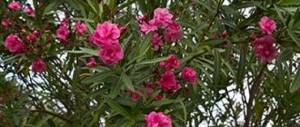This low shrub is easily recognized by its white, fleshy berries, as well as its abundant blooms of pinkish bells. Many people, based on the photo and description, will call it “wolf berry” or snowberry. The botanical classification places the plant in the honeysuckle family, defining it as “white snowberry” (Symphoricarpos albus). The appearance is fully consistent with this: the branches of the bush are completely covered with fruits, as if powdered with snow. The snowflake does not lose its decorative effect either in winter or in summer.
Description
Snowberry is a shrub not exceeding one and a half meters. Belongs to the family of honeysuckle plants, a genus of deciduous and berry plants. Grows in North and Central America, found in Canada.
The leaves of the snowberry are round in shape, reaching five centimeters in size depending on the variety. It begins to bloom at the end of July, the flowers are small, located in inflorescences, and acquire different colors. Flowering continues for a long time and intersects with the formation of berries.
The fruits reach a diameter of one to two centimeters, collected in clusters tightly adjacent to each other. In most cases, the berries are white, occasionally pink, red, and purple. Ripening occurs in autumn, the fruits remain on the bush even during frosts. In winter, birds eat the berries.
The plant is unpretentious and easily takes root in different conditions. It is often used to make garden plots decorative and planted in parks and squares. Snowberry is resistant to diseases and is not damaged by pests.
Main characteristics
Snowberry or snowberry has the Latin name Symphoricarpos and belongs to the deciduous shrubs of the honeysuckle family. The plant is native to North and Central America and is often found in the wild. You can see it in the lower tiers of mountain forests, on river banks or rocky slopes, which indicates the plant’s unpretentiousness to soil and light conditions. For more than 200 years, gardeners around the world have been cultivating snowberry, thanks to which new varieties and hybrids have appeared.
Despite the fact that the shrub has a name associated with snow, there are varieties with pink, white-pink, reddish and exotic black fruits. All snowberries have their own specific characteristics. These include the size and location of leaves and fruits, height and shape of the crown.
A compact bush in nature has a height of 20 centimeters to three meters, but in a summer cottage it is a great success to come across a plant of such size. As a rule, snowberries grown in the middle zone have a height of no more than two meters. Their branches are long and thin, forming a spherical or oval crown, bending under the weight of the fruit.
Foliage and flowers
The leaves of the snowberry are green, from two to five centimeters long, oppositely located, round or oval in shape.
In mid-summer the bush begins to bloom. Its flowers are regular, small, collected 5-15 pieces in group racemose inflorescences of white, pink or red color. There are varieties with single or paired flowering
As a good honey plant, the plant attracts the attention of insects. Flowering continues for a long time and alternates with the appearance of fruits
Description of berries
Fruit ripening occurs in late autumn. With the onset of frost, when all the foliage has already fallen off, the fruits of the snowberry remain on the branches. Snowberry berries are juicy drupes of round or elongated shape up to two centimeters in diameter. They fit tightly to each other, forming clusters. The fruits, soft to the touch when broken, have juicy, loose pulp with two drupes. Snow berries, depending on the variety, can be not only white, but also pink, reddish, white-pink and even inky in color.
The fruits do not fall off after ripening and serve as food for birds. However, eating berries can cause food poisoning for a person, so children need to be explained that these elegant berries cannot be eaten.
Popular snowberry varieties
In nature, there are fifteen species of snowberry. Some of them have gained popularity among people and are planted more often than others.
- White snowberry is a popular plant most often used for plots and designs. An unpretentious bush, white berries, flowering from mid-summer to autumn. Reaches one meter, grows on any soil, and is frost-resistant.
- Pink snowberry is a beautiful plant that grows up to a meter. The flowers are pink and appear in August. The fruits ripen in late autumn and are distinguished by a coral or purple hue. After the leaves fall, the berries remain for a long time. The variety is not resistant to frost, so it is grown in the southern regions.
- The snowberry Dorenbose got its name thanks to the Dutch scientist who bred it. The hybrid combines the properties of several plants. It includes varieties Mother of perl, Magic berry, White Hedge, Magic Candy, Amethyst. They all differ in leaf size, color of flowers and fruits, and growing conditions.
- Western snowberry is found on mountain peaks and coastal areas. Flowering continues throughout the year, the leaves are small, fruits are formed parallel to flowering.
Breeders continue to develop new species of shrubs. Snowberry is popular and is often used in landscape design.
Useful properties of the plant
Snowberry is rarely used in folk medicine due to little knowledge of its properties. In North America, residents knew more about the beneficial properties of the bush and its parts, so they used it to make medicines. What can medicines from snowberry be used for?
- Ulcerative skin lesions are treated with a paste of leaves.
- Burns and cracks disappear after compresses from crushed fruits.
- Infusion from the bark is used to gargle for various diseases.
Remedies from fruits and other parts of the plant help with tuberculosis, pain during the menstrual cycle, sexually transmitted diseases, colds, and pathological processes of the stomach.
The use of a poisonous plant is unacceptable without the permission of a medical professional. When preparing the products, you must carefully observe the proportions and recipe; the administration is carried out strictly observing the dosage.
Notes
- For the convention of indicating the class of dicotyledons as a superior taxon for the group of plants described in this article, see the section “APG Systems” of the article “Dicotyledons”.
- ↑ 1 2
Information about the genus
Symphoricarpos
Index Nominum Genericorum
database of the International Association for Plant Taxonomy (IAPT). - Krasovskaya, 2020.
- According to the Great Soviet Encyclopedia (see Links section)
- Botany. Encyclopedia “All the Plants of the World”: Trans. from English = Botanica / ed. D. Grigoriev and others - M.: Könemann, 2006 (Russian edition). - pp. 865-866. — 1020 s. — ISBN 3-8331-1621-8.
- Konovalova T. Yu., Shevyreva V. A.
Poisonous plants: Atlas-identifier.. - M.: ZAO "Fiton+", 2011. - 112 p. — ISBN 978-5-93457-372-1.
Why is the snowberry dangerous?
Is snowberry poisonous? Many people have eaten the berries of the bush more than once. However, not everyone knows that the plant is poisonous. Snowberry can lead to the development of unpleasant symptoms and overdose.
Intoxication cannot happen by accident - the berries are tasteless and unpleasant. In most cases, small children who eat snowberry fruits out of curiosity suffer. The berries contain an increased amount of saponin and acids. Adults will not experience any discomfort when consuming the fruit; children may develop poisoning.
Is the white snowberry poisonous? It is difficult to answer a question like this precisely. It is as safe for animals as it is for an adult in good health.
Common nightshade
Nightshade berries grow on roadsides or forest edges. The fruits look like small tomatoes, but unlike its distant relative, black nightshade is poisonous. Nightshade contains the alkaloid solanine, which can cause poisoning if consumed. The harmful substances contained in nightshade irritate the gastrointestinal tract, cause vomiting and affect the nervous system. The fruits of the nightshade are bitter, it is unlikely that a person will want to eat them, so it is mainly dangerous for livestock (sheep and pigs) or poultry.
Symptoms of plant poisoning
There is no lethal outcome from eating the berries of the bush, however, if the fruit is consumed in an increased volume, it can lead to the development of poisoning. In this case, the person has characteristic symptoms.
- nausea,
- gagging,
- burning sensation in the mouth,
- painful sensations in the abdomen,
- headaches, dizziness,
- problems with consciousness, apathy, lethargy,
- weakness, reluctance to do something,
- bowel dysfunction, diarrhea,
- fainting state.
In children, such symptoms appear faster and more intensely than in adults. It is possible to develop allergic reactions on the skin if a toxic substance comes into contact with them.
Belladonna
This perennial herbaceous plant reaches 2 meters in height. It is often called witch grass or mad cherry because the fruit tastes sweet and tastes similar to regular cherries. You should not eat them under any circumstances. All parts of the plant that contain the alkaloid atropine are poisonous. Belladonna poisoning causes a decrease in blood pressure, dry mouth, tremors, nausea and irritability, and in severe cases, hallucinations, loss of orientation and delirium.
Prevention measures
It is possible to avoid poisoning by fruits and parts of the snowberry if you follow safety precautions. It is recommended that people planting a plant on the site know them.
- It is necessary to explain to children that snowberry berries cannot be eaten; parents should closely monitor their children.
- Adults are not recommended to eat berries to avoid unpleasant symptoms.
- It is possible to use snowberry as a medicine only with the permission of doctors.
- It is necessary to prepare folk remedies from parts of the bush in compliance with all proportions and recipes; the dosage cannot be exceeded.
Snowberry is a beautiful plant that is often found in nature and design. Due to its properties it is used in garden plots. However, it is recommended to remember that the bush is poisonous and can cause a lot of trouble. Preventive measures will help avoid poisoning.
Reproduction of snowflake
You can propagate snowberries in several ways: cuttings, seeds and shoots. Each of the options should be considered in more detail.
Planting shoots
As it grows, the snowberry bush grows strongly and takes down powerful roots. To make the bushes look unkempt and too dense, they need to be thinned out periodically. Removed unnecessary shoots can be used as planting material. Reproduction in this way is carried out in mid-November.
The shoots are dug up and divided into several parts so that there are several roots on one shoot. Then they are planted in holes with nutritious soil and watered.
Propagation by cuttings
Cuttings are a simple and effective way to propagate snowberries. Healthy lignified shoots are chosen as cuttings. The best option for taking material are shrubs older than 10 years. The cutting is carried out in the fall. The stalk must be at least 10 centimeters long and have several internodes.
Tropical Hoya carnosa: keeping in the apartment
For rooting, the shoots are dipped in warm water. You can speed up the rooting process with special stimulating substances or by dusting the cut with Kornevin. A Heteroauxin tablet dissolved in one liter of water is also suitable as a stimulant.
The cuttings are planted in a nutrient substrate with the addition of sand. The cutting is buried one centimeter, sprinkled with sand on top to a depth of 2 centimeters. The plantings are transferred to a greenhouse and covered with film. During the growth period, cuttings need protection from the sun, high air and soil humidity. Once the plant has taken root, it can be planted on the site. Young shrubs are covered for the winter. Fir branches are suitable for this purpose.
Video: snowberry flower
Snowberry is a perennial plant belonging to the honeysuckle family. An elegant shrub with round white berries stands out among other crops and is widely used as an ornamental. Many people remember this unusual bush, on which, after the leaves fall, juicy, loudly bursting fruits remain. Quite often people wonder whether the white snowberry is poisonous or not? Despite its attractive appearance, the plant is considered dangerous and can cause poisoning.
Planting a crop
To plant a snowberry on your site, there is no point in thinking about its location. This bush feels great both in the sun and in the shade , both on a flat area and on a slope, both in wet and dry soil. The plant can be planted in open ground both in spring and autumn. In any case, the soil must be prepared in advance.
In order to plant a hedge, you need to stretch a rope along the proposed hedge and dig a trench along it 60 cm deep and 40 cm wide. Bushes must be planted at a distance of 150 centimeters from each other. If planting will be carried out in the spring, the trench is prepared in the fall, if in the fall - in the spring. This is especially true for loamy soils, since by the time of planting it must settle.
Growing scindapsus aureus in an apartment
A layer of crushed stone is laid at the bottom of the trench, then a fertile soil mixture. You can make it as follows. Mix:
- river coarse sand;
- humus or compost;
- peat;
- 600 g of wood ash for each bush;
- 200 g of dolomite flour for each bush;
- 200 g of superphosphate for each bush.
After planting, the plant is watered, mulched, and the soil is compacted. In the first five days, the bush needs to be watered daily.
Description
Snowberry is one of the most beautiful plants, the peculiarity of which is its snow-white berries, which are food for birds. Its genus includes about 15 species: some varieties of snowberry have pink, red and even black berries.
A deciduous shrub native to America reaches a length of up to 1.5 meters, has long thin shoots and small flowers.
The fruits are able to remain on the bush almost all winter, which is why the plant got its name.
The leaves of the snowberry are oval-shaped, up to 5 cm long, the flowers are small with pinkish corollas, bloom from late spring to early autumn.
Peculiar round fruits, up to 1 cm in diameter, are collected in tassels and contain two seeds. The berries ripen in early autumn and are able to survive frosts. An unpretentious plant takes root well in various conditions. Snowberry is often planted as a hedge or used in single plantings as a decoration for summer cottages and flower beds. It is believed that the berries of the bush are poisonous due to the high content of alkaloids, but are not capable of causing much harm to an adult. However, when consumed in large quantities, they can cause severe intoxication, especially in children.
The gentle charm of white snowberry
This low shrub is easily recognized by its white, fleshy berries, as well as its abundant blooms of pinkish bells. Many people, based on the photo and description, will call it “wolf berry” or snowberry.
The botanical classification places the plant in the honeysuckle family, defining it as “white snowberry” (Symphoricarpos albus). The appearance is fully consistent with this: the branches of the bush are completely covered with fruits, as if powdered with snow.
The snowflake does not lose its decorative effect either in winter or in summer.
Useful and dangerous snowberry
The homeland of the plant is Northern. America. Local Indians, and then European settlers, knew its medicinal properties, using them to heal wounds and cuts on the skin. Fresh juice was used to treat stomach ulcers and various ulcers. It was believed that snowflake helps to cope with sexually transmitted diseases and tuberculosis. Nowadays, berries are used in traditional pharmacology and folk medicine.
Attention! The chemical composition and properties of snowberry have not been thoroughly studied. It should be used with caution and only after consulting a doctor.
The toxic compound saponin, contained in all parts of the “wolfberry”, makes the shrub inedible. There is especially a lot of this substance in fruits, which when ingested cause vomiting and dizziness. Snowberry poisoning in children is very difficult. Interestingly, many forest animals and birds eat snowberry berries. In addition to the dangerous substance, there are:
- Sahara;
- min. salt;
- acids.
Snowberry fruits
Snowberry is an excellent honey plant. Long-lasting flowering and an attractive aroma for bees puts it on par with buckthorn, yellow acacia, and heather.
Description of the snowberry and its types
There are about fifteen species in the genus “snowberry”. Among the most studied:
- Mexican.
- Coral berry.
- Round-leaved.
- Chinese.
- West.
All species are deciduous, not exceeding 3 m in height. In the wild, they are found not only in forests, but also in mountainous areas, as well as in open, dry areas.
Snowberry is very unpretentious, feels equally good in both sunny and shaded areas with almost any type of soil. White snowflakes are usually used for decorative purposes. This species is resistant to cold, drought, and also to severe air pollution.
White snowberry does not grow higher than 1.5 m. The foliage is small, oval. The leaf is green on top and bluish underneath with small fluffy fibers. The bushes are easily propagated by young root shoots, cuttings, and seed propagation is possible.
The crop blooms at the very end of spring - May. Continuous flowering lasts until September; berries and buds can immediately be seen on the branches. The fruits ripen in autumn, appearing as soft drupes with two seeds inside. Ripe snowberry clusters do not fall off, but last all winter.
To decorate your garden, you can choose a varietal:
- Doorenbosii Mother of Pearl;
- Magic Berry;
- Amethyst.
Obtained from the heat-loving hybrid species Dorenboz, these varieties have pink, pink-pearl berries. Unfortunately, the winter hardiness of plants is only -10 °C.
Caring for the “snow berry”
To make the bushes look attractive, they are pruned in early spring, removing long branches or branches that disrupt their shape. Once every 7–8 years, renewal pruning is carried out, leaving no more than 0.50 cm from the above-ground part. In summer, green shoots will appear from the buds.
Advice. If shoots with a diameter of more than 7 mm are cut, the damaged area is smeared with garden varnish.
Snowberries are planted either singly or in groups. “Hedges” look good. To do this, focusing on the stretched fishing line, make a groove 60 cm deep and 40–45 cm wide. This is done in advance, for example, if planting is planned for spring, the area is prepared in the fall.
The bottom is covered with crushed stone or brick chips, then with soil. The mixture can be prepared as follows:
- coarse river sand;
- peat;
- compost.
- wood ash and dolomite flour (600 g per bush).
As min. component - superphosphate (200 g per bush). During the first days, the area with the planted white snowberry is watered and mulched. During the summer, one feeding with a liquid solution of Agricola is enough. In spring, organic matter and minerals are added. complex. Water the snowfield during severe drought (1–1.5 buckets per bush). In the fall, the soil around the planting is dug up.
The poisonous snowberry does not suffer from pests. Sometimes you can notice gray rot or powdery mildew on plants; the bushes are sprayed with fungicidal preparations.
The long, gracefully bent branches of the snowberry look very impressive. They are quite flexible - they do not break under the weight of berry brushes. An undemanding shrub will enliven the front lawn or a hidden corner of the garden. Knowing some of the features of this plant, it is very easy to “make friends” with it.
Plants for the garden: video
Source: https://sad24.ru/derevya/nezhnoe-ocharovanie-snezhnoyagodnika.html
Beneficial features
The chemical composition of the bush has been little studied, so the bush is rarely used in folk medicine. However, North Americans, aware of its disinfectant and antimicrobial qualities, used its fruits, leaves and bark to treat wounds.
Crushed leaves were often used to heal ulcers on the hands, and compresses from crushed fruits were used for burns and cracks in the skin. In addition, they gargled with an infusion of snowberry bark and used the decoction to treat tuberculosis, venereal diseases, menstrual pain, colds, and stomach pathologies.
Despite this, the plant should not be used without consulting a specialist.
Why is the snowberry dangerous?
Perhaps each of us had to pop white snowberry berries - this was a favorite pastime in childhood. However, despite its apparent harmlessness, the plant is poisonous.
The snow-white berries of the bush are unpleasant to the taste and inedible, so it is impossible to accidentally become poisoned by them. Most often this happens to young children who, due to their age, can taste the beautiful white berries.
Symptoms of poisoning
The bush does not pose a mortal danger to human life. However, if you eat large quantities of berries, the following symptoms of poisoning may occur:
- nausea;
- gag reflexes;
- burning sensation in the mouth and throat;
- pain symptoms in the abdomen of a paroxysmal nature;
- dizziness;
- impaired consciousness, lethargy;
- feeling of weakness;
- upset stomach in the form of loose stools;
- fainting.
When a toxic substance gets on the mucous membranes and skin, the following manifestations occur:
- irritation and redness of the skin;
- local swelling;
- painful sensations, the intensity of which depends on the affected area, the duration of action of the poison and the individual characteristics of the victim;
- If left untreated, inflammatory processes may occur.
If the substance gets on the skin, first aid is to wash the affected areas with water. For internal use, the patient must undergo symptomatic therapy. To do this, the victim is given gastric lavage, activated carbon or a glass of milk, which neutralize the toxic compound. In a serious condition accompanied by fainting, the poisoned person is immediately transported to a medical facility.
To prevent intoxication from poisonous berries, you need to remember the main safety rules: do not eat unfamiliar fruits, and also do not leave children unattended for a long time.
White snowberry is one of the most beautiful shrubs grown in central Russia. From September, and then until frost, white spherical berries, collected in a dense cluster, hang on its branches, giving it the appearance of a snow-covered bush. For this beauty, it was popularly called “snow berry.” Brought to us from North America, where about 15 of its varieties are found growing wild. In Russia, the most common species is white or clustered snowberry.
Botanical description
White snowberry (Symphoricarpos albus) is a perennial low shrub of the Honeysuckle family. The shrub is unpretentious, prefers calcareous, rocky soils, grows quickly, reaches a height of about 1.5 meters, the life of the plant is 50-60 years. Loves sunny areas, tolerates both low and high temperatures, is resistant to diseases and pests. Begins to bear fruit abundantly in the 3rd year. It tolerates pruning well; after reaching two years of age, a shaped bush can be formed. A peculiarity of this plant is its intolerance to waterlogging, therefore, it should be watered rarely and only in the evening.
Seasonality of the bush
The shrub is beautiful at any time of the year. In spring, it is covered with small green-gray leaves, forming something like a “balloon” due to the shape of the crown. Then abundant flowering begins, which lasts 50 days and ends only at the end of summer. At this time, it is especially attractive to bees, as it is an excellent honey plant. Even during rain and cool weather, nectar continues to form on the flowers.
In August, clusters of white berries-balls form on the branches, which make the bush look elegant for several months. Even when the leaves have fallen, the bush is strewn with berries, like snow. The berries are inedible with a bitter, unpleasant taste and pose a danger to humans, but are absolutely harmless to birds and small animals. In autumn and winter, birds, mice, hazel grouse, partridges, and hares feast on them.
Related varieties
According to the latest data, 17 species of plants of this genus are known, but breeding work on this species continues.
In addition to the white snowberry, the pink snowberry (Symphoricarpos orbiculatus) is very popular. It is distinguished by its larger size and pink berries.
White and pink snowberry have become the base varieties for creating Dorenboza snowberry hybrids. (Doorenbos Hybrids). They were bred by the Dutch breeder Doorenbos by crossing two varieties (white and pink) to increase the compactness of the bush, for an interesting new coloring of the berries. Hybrids are characterized by short stature (no more than one meter), as well as more spreading branches. The fruits resemble porcelain beads, the color ranges from white with a pink tint to bright pink, as well as crimson.
The Chinese snowberry (Symphoricarpos sinensis) differs from its “relatives” in the shape and color of its berries. It is the only one among all that has egg-shaped berries of a rich black color; it is practically not grown here, since even with covering material it cannot withstand frost.
Is White Snowberry Poisonous or Not – No Toxins
Snowberry, or snowberry, (Symphoricarros) is a perennial also known as wolfberry. The culture is widely used in decorative floriculture. Well suited for decorating park areas and local areas.
Medicinal properties and edibility of snowberry
The ornamental bush forms spherical or ellipsoidal fruits, which click very characteristically when crushed.
The name of the plant is due to the coloring of the fruits produced, but varieties with pink berries are also known, which also pop when pressed firmly.
Snowberry is a fairly common plant in our country. In English, such plants are called Waxberry and Ghostberry.
The shrub is poisonous , but has medicinal properties that have been known for a very long time by the peoples of North America, where it was used to get rid of purulent wounds, abscesses and ulcers, in the treatment of cracks in the hands and feet, as well as in the treatment of venereal diseases and tuberculosis. This shrub cannot be considered edible, and before using the medicine it is imperative to consult a specialist.
Snowberry - perennial also known as wolfberry
Description of snowberry varieties
Snowberry bushes (Symphoricarros) are rather low shrubs. The maximum height of the above-ground part, as a rule, does not exceed one and a half meters. The branches are long and quite thin. During the period of ripening of the berries, under the weight of the bunches, the shoots fall down , which gives the plant an almost regular spherical shape.
The foliage is slightly elongated, ovoid in shape, with a green upper leaf blade and a bluish tint on the back side. The berries are collected in clusters, have a round shape, and reach a diameter of 10 mm. The coloring of fruits directly depends on the species characteristics.
Common snowberry (rounded)
Round snowberry (S.orbiсulatus Moenсh) is a deciduous shrub with an aerial part up to two meters high. The shoots are thin, brown or reddish. The foliage is opposite, ovate-rounded, entire. The upper side of the castings is dark green in color, while the lower side is lighter and pubescent.
In autumn the foliage turns red. The flowers are small in size, bell-shaped, pinkish-white in color, collected in short racemes, formed in the leaf axils.
Flowering in July-August, after which spherical fruits with a diameter of 4-7 mm, purple-red in color are formed, which ripen in the fall.
Rounded snowberry (S.orbiсulatus Moench)
Snowberry white (tassel)
White snowberry, or brushy (S. albus) is a deciduous shrub no more than one and a half meters high, with thin branches and opposite, ovate or oval, entire leaves up to 50 mm long. The upper side of the foliage is green and bare, and the lower side is gray and slightly pubescent.
The small flowers have a bell-shaped pink corolla and are collected in dense racemose inflorescences formed from the leaf axils.
Flowering begins in May and lasts until September, after which spherical white fruits are formed, up to 10 mm in diameter, which do not fall off for a long time.
White snowberry, or cysticus (S. albus)
Snowberry Shenot
Shenot's snowberry (Symphoricarros x Chenaultii) is a hybrid of pink, round and small-leaved species. It was bred by French breeders more than a century ago.
Deciduous shrub is characterized by the formation of arched hanging stems, which, touching the soil, take root very easily and quickly. The flowers are small, pink in color, collected in lush axillary inflorescences.
The formed fruits are distinguished by a lilac-pink or beetroot hue. The most widespread variety is Hancosk , which has spreading branches lying on the surface of the ground.
Shenot's snowberry (Symphoricarros x Chenaultii)
Mountain-loving snowberry
Mountain-loving snowberry (Symphoricarpos.utahensis Rydb.) is an erect or creeping deciduous shrub no more than one and a half meters high with reddish-brown shoots and light brown buds. The foliage is opposite, located on short petioles.
The slightly pubescent leaves have a round or oval shape. The flowers are white or pink, bell-shaped, singly or in pairs. Flowering from the first ten days of July until the end of summer , after which spherical white berries are formed.
Mountain-loving snowberry (Symphoricarpos.utahensis Rydb.)
Snowberry of Doorenbos (Dorenbosa)
Doorenbos snowberry (S.doorenbosii) is a hybrid obtained as a result of crossing the white and round species.
It is represented by several varieties of Dutch selection, and the most popular are Magic berry with pink inflorescences and scarlet berries, White Hedge with large snow-white flowers and berries, Amethyst with white berries with a lilac tint, and Mother of Pearl forming snow-white fruits with a pink tint.
Snowberry of Doorenbos (Dorenbosa)
Western snowberry
Western snowberry (S.ossidentalis) is a shrub plant up to one and a half meters high, forming dense growth. Young branches are pale green or slightly reddish in color, while older shoots are grayish-brown.
The foliage is dense, leathery, oppositely located, elliptical or ovoid, up to 60 mm long, grayish-green in color, with pubescence on the underside. The flowers are snow-white or pale pink, bell-shaped, collected in short and dense racemes.
Flowering is always very abundant and quite long , with the formation of white or pink fruits that ripen in the fall.
Western snowberry (S.ossidentalis)
Is the shrub with white berries poisonous or not?
The round snow-white berries ripen at the end of summer, after which they overwinter on the shrub plant until the onset of spring warmth.
Despite their rather attractive and seductive appearance, such berries are absolutely inedible and can cause poisoning.
However, the toxic effect is exclusively on humans, and many birds eat the fruits with great pleasure in the winter. Domestic gardeners use snowberries only as an ornamental plant.
Snowberry propagation technology
Seed propagation is a labor-intensive process and requires a lot of patience, therefore, in the conditions of home gardening, cuttings are more often used or layering and shoots are used.
Seeds
The seeds are removed from fully ripened berries and thoroughly washed. Clean seed material must be dried. For sowing seeds, a light and nutritious soil mixture based on peat, clean river sand and humus is used.
The seed material is sown surface-wise, after which it is sprinkled with a thin layer of clean sand and covered with plastic film. In the last spring month, the strengthened and grown seedlings are picked and then transplanted to a permanent place in open ground.
Before planting, it is recommended to stratify the seeds, which improves germination rates and allows you to obtain the highest quality and strongest seedlings.
Seed propagation is a labor-intensive process that requires a lot of patience.
Cuttings
Propagation by green and lignified cuttings is one of the easiest and most convenient methods. Lignified cuttings should be no more than 20cm long and have four to five buds. The upper cut is made above the kidney, and the lower cut is made obliquely. Until spring, planting material is stored in sand.
Green cuttings are harvested in the first ten days of summer. Planting material must be cut from well-developed and fully mature shoots, after which it is placed in water.
Planting is done in a soil mixture based on peat, clean river sand and humus with a depth of about a centimeter.
Propagation by green and lignified cuttings is one of the easiest and most convenient ways
By layering
In early spring, it is necessary to bend a low-growing young shoot, place it in a groove made in advance in the ground and sprinkle it with soil, only the apical part should remain above the surface.
Throughout the summer, you need to care for the layering. It is necessary to water and fertilize them together with the bushes, and to loosen the soil shallowly.
In the autumn, fully rooted cuttings are separated from the parent plant using pruning shears and transplanted to a permanent location.
In early spring, it is necessary to bend a low-growing young shoot, place it in a groove made in advance in the ground and sprinkle it with soil.
Overgrowth
An ornamental shrub is characterized by the formation of a significant number of root suckers or so-called shoots. If necessary, such clumps can be used for plant propagation. Among other things, periodic removal of shoots helps to avoid thickening of the bush.
Also read: Winged euonymus: types and varieties, rules for caring for the plant
Planting and caring for shrubs
Experts recommend planting shrub plants with early flowering in the autumn. Late-flowering crops are best planted in the spring.
The ornamental crop is very unpretentious and can adapt to almost any growing conditions, but planting in sunny areas or in some shade is optimal.
The crop is a very good honey plant, but in heavily shaded areas the shrub can take on an unsightly appearance.
An ornamental shrub is characterized by the formation of a significant number of root suckers or so-called shoots
When planting, it is advisable to provide the root system of the ornamental shrub with basic nutrition, regardless of the size of the planting material. As a rule, the dimensions of the excavated planting holes are 0.5x0.5x0.5 meters.
Planting holes must be filled with fertile soil , since the root system takes root better in nutritious soils.
The root system of an adult perennial crop grows on average one and a half meters, so the standard distance between planted shrubs should be a couple of meters.
If necessary, the exposed root system of perennial seedlings can be treated with a clay mash.
To increase survival rate, soak the roots in water with the addition of rooting agents. The best proven products are “Heteroauxin”, “Kornevin” and “Rizopon”.
When planting, it is very important to deepen the plant sufficiently, which will prevent the massive appearance of root shoots.
The decorative perennial crop does not require special care, but the bush should not be overly dense . As a rule, sanitary pruning of the above-ground part is carried out.
In the autumn, it is necessary to carry out sanitary pruning with the removal of all dry and broken shoots. In this way, it is possible to well stimulate growth processes in young shoots. In winter, it is necessary to shake off the snow from the bush; this will prevent the branches from breaking off the floor due to the weight of the snow mass.
You can shape the crown and shape the appearance of the shrub during the pruning process in almost any way.
Also read: Cotoneaster: description of species, features of planting and care
Snowberry hedges (video)
The crop can easily tolerate increased gas pollution and high levels of smoke. In garden plots, it is recommended to plant shrubs as a hedge to protect them from highways.
(13,50
Source: https://beztoksina.ru/yadovityj-ili-net-belyj-snezhnoyagodnik.html
Distribution area
In natural conditions, wild snowberry prefers river banks, mountainous forest areas, slopes, and ravines. The main distribution area is North and Central America.
White snowberry is widespread in Canada and the northern part of the United States. In Russia it grows well in the middle zone, in the Urals, in Siberia, withstanding frosts down to -30°C. Young plants can freeze, so it is better to cover them with spruce branches, straw, and pin the branches to the ground.
Pink snowberry is common in southern America. In Russia, the southern regions are more suitable for it due to prolonged warmth and less humidity. Although, with proper winter shelter, this variety can be grown even in the middle zone. But in cold and rainy summers, the bush does not reveal its capabilities, and may even stop developing. Widely used to decorate parks and streets.
The pink snowberry hybrid, the Cheneau snowberry, has average frost resistance, but due to its small size, it is popular among gardeners. This variety is an excellent honey plant.
Most Dorenboz hybrids require shelter for the winter; they keep the temperature only down to -8-10°C below zero, and can freeze out. In addition, in the middle zone there are often cool summers, as well as a small number of sunny days, then the bush does not have time to ripen. Snowless winters are also dangerous for him.
These varieties are the most popular among Russian gardeners, but the variety of snowberry species is not limited to them.
Western snowberry is common in the eastern, central, and western regions of North America. Mountain snowberry is found in the mountain forests of western North America at an altitude of 2700 m above sea level. Small-leaved snowberry or Mexican - the southernmost type of variety, found in Mexico, Guatemala, can grow at an altitude of up to 3000 m above sea level. The soft snowberry prefers open sunny places with a subtropical climate on the California coast, in the northern Mexican Highlands. It is part of the chaparral ecosystem, which is defined as an ecosystem with rainy winters and dry summers.
Planting snowberries in open ground
Like every plant, wolfberry requires proper care and planting. It can be planted at any time of the year. The peculiarity of the plant is that it does not matter what soil you plant it in, it will still grow.
If you want to make a beautiful thick hedge, then you need to buy 2-4 year old snowberry seedlings. It is important to ensure that the root system is intact and not affected by disease.
We suggest you read: How to make a staircase to a cellar (basement) with your own hands
To plant a hedge in open ground, you need to pull the twine along the drawn line and dig holes. Plants should be at a distance of at least 120-140 cm. It is important that there are not 4-5 shrubs per 1 linear meter of trench.
Growing in the garden
The holes should be prepared in advance: if planting is carried out in the fall, then the hole is dug a month in advance, for spring - in September-October. If the area has clay soil, then you need to wait until the ground settles a little. Before planting, lay out crushed stone, river sand, compost and peat. Sprinkle the top with dolomite flour, superphosphate, and wood ash in the ratio of 200 g: 200 g: 600 g. After this, plant the seedling. The first days the future bush must be watered every day.
Pruning in spring
Pruning is a must; it is best to carry out this process in the spring before the sap begins to flow out. First, dry, damaged, old and disease-affected ones are cut off and treated with garden varnish.
Since it is unpretentious, you don’t need to care for it, but if you take a little care of it, it will bloom and look even more beautiful. Care includes mulching the soil, eliminating weeds, moderate watering and protection from pests.
Watering should only be done in dry weather in the evening. In rainy weather there is no need for watering. In autumn, the plant can be dug up.
Those who have little space in the garden can plant a snowfield as a hedge. This is very convenient, since the shrub can grow equally well in partial shade or in the sun, and can be cut easily and any way you like. The distance between the bushes when planting a hedge is approximately 60 centimeters.
When choosing a place to plant a snowberry, there is no need to think about whether it will grow in this particular area. The snowman feels great both in the shade and in the sun. Poor soils, sandy or rocky, will not be an obstacle to planting snowberries and caring for them in open ground.
The shrub can be planted in both spring and autumn. The main condition for rapid rooting of a plant is good soil moisture. Adding organic fertilizer will help the plant get established. Having planned the landing site, you need to prepare it. For autumn planting, it is necessary to dig holes about 60 centimeters deep and the same in diameter within a month, fill them with a mixture of crushed stone and a substrate consisting of humus, river sand and peat. Additionally, under each bush the following is added:
- superphosphate - 200 grams;
- dolomite flour - 200 grams;
- wood ash - 600 grams.
For planting in spring, all work must be done in the fall.
If you are planning not a single or group composition, but planting a snowberry as a hedge, you need to dig a trench 45 centimeters wide and 60 centimeters deep. The planting density is 3-4 plants per 1 linear meter.
After planting the plant, the soil around it needs to be compacted, watered well at the rate of 1.5-2 buckets per bush and the tree trunk circle mulched with a 5 cm layer of peat. After planting, you need to make sure that the root collar of the seedling is at ground level. It is necessary to water the seedlings for 5-7 days after planting, provided the weather is dry.
The unpretentious snowberry will grow even if you don’t care for it at all. But like any plant, surrounded by care, it will look healthy and well-groomed if you put in just a little work.
In dry summers, the shrub needs watering, which is best done in the evening in the amount of 1.5-2 buckets per plant. The soil in the tree trunk circle needs to be loosened and weeded. If the weather is humid, there is no need to water the snowberry. In autumn, the soil around the plant must be dug up.
Snowberry can do just fine without fertilizing. But how will it bloom and bear fruit if you feed it with organic fertilizer! Only 2 times. In the spring, take 5-6 kg of humus and add 100 grams of potassium salt and superphosphate, apply under the plant. Then in the summer, when the fruits begin to set, you need to use any fertilizer for berry crops.
In the spring, it is necessary to carry out a control inspection of the plant and identify branches that have dried out and were damaged during the winter. Cut off such shoots completely. There is no need to be afraid to prune healthy branches either, since the plant lays flower buds in new shoots. Healthy branches need to be shortened by half their length.
Winter period
When choosing a snowberry variety, you need to pay attention to the frost resistance of the plant. If the variety is cold-resistant, then the shrub does not need additional shelter and will withstand frosts down to -35 °C
In regions with harsh winters, even a frost-resistant snowberry variety must be hilled high and covered with spruce branches and dry leaves.
When the question arises of what to plant on a summer cottage or garden plot, the choice in favor of a snowberry is obvious. For experienced and novice gardeners, an important factor is the unpretentiousness of the plant and its unconditional decorativeness. This will allow you to realize your design abilities in landscaping the site without spending a lot of time and effort.
Snowberry is an unpretentious plant, but good care will not hurt. If you properly prepare the holes for planting, the yield of the shrub will increase, and therefore its decorative qualities.
To plant a hedge, you need to dig a trench about 60 cm deep under the stretched twine. Place broken brick or expanded clay at the bottom as drainage. Fill the rest of the space with a nutritious mixture of peat, river sand, humus or compost - whatever you can find. Add dolomite flour - a complex fertilizer that stimulates the development of the root system. Compress the finished soil a little or wait a few days until it settles completely.
Same-aged seedlings are placed in a trench at intervals of 25 cm. The roots are first dipped into liquid clay. After planting, the top layer of soil can be mulched with peat. During the first days, in the absence of rain, watering with the addition of superphosphate is necessary. Then the seedlings can be left alone: they will overwinter well. Hedges made from white snowberry strewn with fruits look beautiful both in autumn and winter.
To obtain a luxurious single bush, the snowberry is planted on the lawn, providing at least a meter radius of free space. The well is prepared in a similar way. Start pruning the bush at the age of two, in early spring, before the sap begins to flow. Exquisite hybrids of snowberry dorenboza will turn the garden into a real botanical museum.
In addition to forming a hedge, snowberry is used:
- in landscape planning (in the background of flower beds, in combination with viburnum or rowan bushes, white snowberry is planted in groups of trees with dark needles);
- to strengthen slopes (combined with ground cover grasses and planted in groups);
- for making bouquets (with dried flowers, in bridal bouquets).
North American Indians also used white snowberry for medicinal purposes. But the effect of such treatment has not been proven. The only obvious thing is the beneficial effect that a well-groomed plant has on the soul of a hardworking gardener.
Use in medicine
The healing properties of the plant have practically not been studied. We have received information that the indigenous people of America used the berries, ground to a mushy state, to treat purulent wounds and ulcers, and a decoction of the bark was used for sexually transmitted diseases and tuberculosis, but no real recipe was found.
Modern medicine does not use berries. Although traditional medicine recommends them for wounds and irritations on the hands, as well as for making the skin soft and smooth. Several berries are ground, applied to damaged areas, and after a few hours washed off with soap and water. For cracks on the soles of the feet, rough keratinized skin on the feet, it is also possible to use a mixture of mashed berries. It is not recommended to keep the composition for longer than 3-5 hours; the course is 7-10 days. The best results are obtained by white snowberry.
Shrub care
Snowberry is a plant that requires virtually no care. It will grow and bloom even if it is not looked after. However, if you give the plant at least a little attention, it will delight you with lush flowering and many fruits. Basic snowberry care includes watering, fertilizing twice a year and pruning.
Watering and fertilizing
In the summer, the snowberry plant does not need to be watered if there is sufficient rainfall. If the summer is dry, you can water in the amount of one to one and a half buckets for each bush. After watering, the soil can be loosened.
In autumn, it is recommended to dig up the soil around the bush. Fertilize the snowfield in spring and summer. In the spring, about five kilograms of humus or compost, potassium salt and 100 grams of superphosphate are added under the plant. In summer, the bush is fertilized with Agricola solution (50 grams per 10 liters of water).
Spring pruning
Snowberry tolerates pruning quite well. It must be carried out in early spring before sap flow begins. When pruning, you can shape the crown of the bush, and it is necessary to remove all diseased, damaged and dry branches, as well as branches that thicken the bush and spoil its appearance. If the cut is 7 mm in diameter or more, it must be treated with garden varnish.
On mature bushes (more than eight years old), flowers and berries very often become smaller. If these signs are noticed, then it’s time to carry out anti-aging pruning “to the stump” (at a height of 50–60 cm). During the summer, strong young shoots form from dormant buds.
Caring for decorative Kalanchoe at home
Pest protection
Since snowflake is poisonous, pests most often avoid it. It is extremely rare that a shrub can be affected by powdery mildew or gray rot of fruits . To prevent this from happening, it is necessary to pre-treat the plant.
Treat the snowberry in early spring before bud formation with a solution of Bordeaux mixture. If the treatment was not carried out and the plant became sick, it is sprayed with one of the following fungicides: Skor, Topaz, Jet. Any drug from this series will do.
Transfer to a new place
If for some reason you need to replant the snowberry, you should do it as quickly as possible, before the shrub has grown a powerful root system. The older the plant, the longer its roots. In an adult bush, they can be up to 100 centimeters long, which increases the likelihood of them being damaged when dug up. In this case, you will have to dig up all the ground at a radius of about 70 centimeters around the snowfield.










